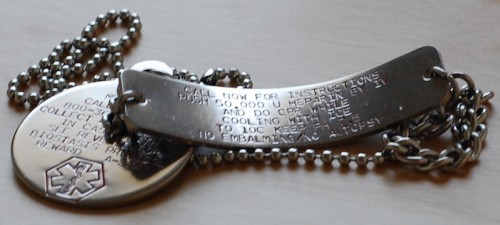I am signed up for cryonics. I applied in April of 2009 and finished the paperwork in September. I am Alcor member A-2447; signed up for whole-body cryopreservation and funded by a whole life insurance policy.
Many of my friends, family, and coworkers know this already. If you didn’t know, you’re probably wondering, “Why?”
The decision to pursue cryonics really comes down to answering two questions: “How likely is it that cryonics will work?” and “Is life extension desirable and moral?” Others have answered the second question better than I can, so I’ll just talk about the current feasibility.
Accurately evaluating cryonics requires knowledge scattered across many disciplines. Even so, the basic principle can be understood by anyone: Frozen meat lasts a long time.
I first heard about cryonics in high school. I knew that water expanded when frozen, and wrote off cryonics as a crackpot idea that would never work. It was obvious: ice crystals damaged cells irreparably. There was no way anyone could revive a frozen body. Case closed.
Until early 2009, when I stumbled on Overcoming Bias. A couple of posts discussed cryonics, and caused me to reconsider it. After seeing electron micrographs of cryopreserved brain tissue, I read more. I realized the idea wasn’t so crazy.
This post on Less Wrong got me to start the paperwork. Signing up is rather involved. Major steps include becoming a member of a cryonics provider, securing funding (usually a life insurance policy), and notarizing and witnessing paperwork. For me, the whole process took several months.
While Eliezer Yudkowsky’s post convinced me to sign up for cryonics, the most persuasive writing in the world won’t convince reality that cryonics works. Cryonics either works or it doesn’t. Finding the answer requires examining evidence. So, bring on the evidence!
This presentation by Brian Wowk does a good job showing the state of cryopreservation technology:
For those who don’t want to spend 25 minutes watching the video, the main points are:
-
The common conception of freezing damage is backwards. Ice doesn’t cause cells to expand and burst. Ice crystals form between cells, dehydrating and squishing cells as the crystals grow.
-
Cryoprotectants can limit or even eliminate ice formation at liquid nitrogen temperatures. Instead of freezing, the solution increases in viscosity as temperature drops. Around -120ºC, the solution reaches its glass transition temperature and becomes an amorphous solid.
-
Cryoprotectant research is ongoing. A decade ago, cryoprotectants needed cooling/warming rates of 70ºC per second to prevent ice formation. Cell survival rates were around 50% in tissue samples. Today’s cryoprotectants can revive 90% of cells with cooling/warming rates of less than 1ºC per second.
-
Wowk’s team used their current best cryoprotectant (M22) to successfully cryopreserve, thaw, and transplant rabbit kidneys.
-
Based on evidence from victims of hypothermia, barbituate overdose, and cardiac arrest, silencing electrical activity in the brain doesn’t erase any long-term memories. Cryopreserving the brain should preserve all aspects of self.
-
SEM micrographs of cryopreserved brain tissue show fine structure is preserved. Individual axons are unharmed. Even synaptic vesicles are preserved.
-
Cooling cryoprotectant solution too far below the glass transition temperature will cause fracturing from thermal stresses. While they make revival harder, the fractures are few in number and typically cause simple translations of tissue. The information destroyed is negligible.
-
Despite limited funding, cryopreservation techniques have improved substantially. Cryopreservation and transplantation of large organs is expected in 10 years.
Alcor uses M22 to cryopreserve the brains of their customers. The Cryonics Institute uses a similar solution. If Alcor or CI gets to you in time, the structure of your brain will be accurately preserved down to the nanometer scale. Everything we know about chemistry, biology, and neuroscience tells us that this process preserves all the information required to reconstruct a human mind.
The biggest unknown in cryonics is the revival process. Right now it’s completely speculative. People have thrown some ideas around, but all require major advances in current technologies. Some even require inventing new technologies (such as molecular nanotech). So today, a few unaugmented, 21st-century, biological humans have given it some thought but haven’t built revival technology. But the information in cryopreserved brains will wait patiently for a solution. Cryonics organizations pay for indefinite maintenance with the interest from low-risk investments. Failure requires that no future intelligence ever finds a way to revive people.
Based on this evidence, I’m very sure the preservation process works. My doubts are about the future. I assign a low probability to being revived: around 5%, since a lot of things have to go right. The biggest thing being that humanity has to not destroy itself. While 5% is a small likelihood, it’s still worth paying for. Any civilization with the means and desire to revive people will be a very nice place to live. And members of that civilization would live a very long time. Quality of life would probably be better than most current depictions of heaven. I am not kidding.
When I told people, reactions varied. My mother laughed. My father and siblings thought it was weird and sort of interesting. I don’t think any of them took it seriously. I guess I’m too timid to say, “It’s your funeral.”
Well, too timid to say it face-to-face.
